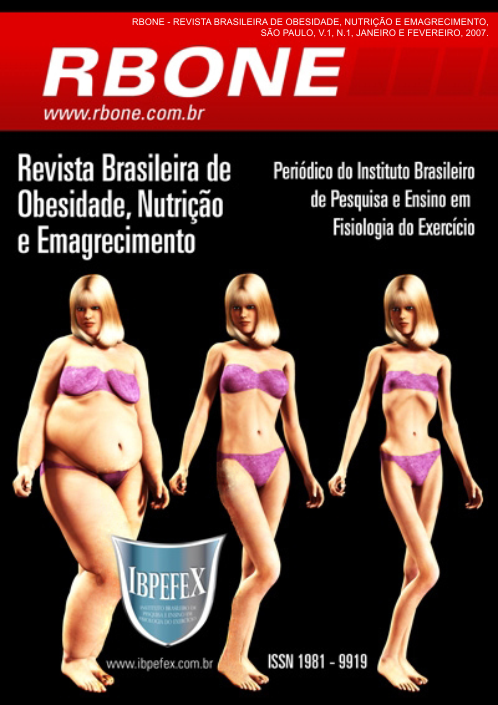Influence of nutrition and obesity on hyperuricemia and gout
Abstract
Hyperuricemia is commonly detected in subjects with abnormal purine metabolism, including overproduction of uric acid and insufficient uric acid excretion from the kidney. Gout is a type of inflammatory arthritis that is triggered by the crystallization of uric acid within the joints and is often associated with hyperuricemia. The genetic is the major factor of hyperuricemia, however another factors are too important like alcohol, obesity and high purine intake. Obesity is a risk factor for hyperuricemia and a weight loss is essential for the treatment. The alcohol was also proposed as a mechanism involved in the rise levels of plasma purine bases. Beer is more prejudicial than the wine. Purine-rich food increases the levels of uric acid and there is an increased risk of gout with higher meat consumption or seafood consumption but not with higher consumption of purine-rich vegetables. Furthermore, there was found a strong inverse association between the consumption of dairy products, especially low-fat dairy products, and the incidence of gout. Restriction of purine intake is necessary to avoid the increasing of exogenous purine. The others guidelines for the treatment of gout can be adopted like a diet rich in carbohydrate (50 a 55%) and poor in lipids (<30%). In conclusion, the weight loss for obese person, and the increases of fruits, vegetables and dairy products on a diet are satisfactory to reduce the incidence of gout.
References
- Choi, H.K.; Atkinson, K.; Karlson, E.W.; Willet, W.; Curhan, G. Purine-Rich Foods, Dairy and Protein Intake, and the Risk of Gout in Men. N Engl J Med. 2004; 350(11):1093-103.
- Choi, H.K.; Mount, D.B.; Reginato, A.M. Pathogenesis of Gout. Ann Int Med. 2005; 143(7): 499-516.
- Corbella, M.J.G. La Alimentación del Paciente Hiperuricémico: Manifestaciones Clínicas y Recomendaciones Dietéticas. Offarm. 2005; 24(9): 110-12.
- Decker, R.T. Cuidado Nutricional nas Doenças Reumáticas. In: Mahan, L.K.; Escott- Stump, S. Krause: Alimentos, Nutrição e Dietoterapia. 9ª edição. Cap. 40. 917-18. Roca. São Paulo. 1998.
- Ene-Stroescu, D.; Gorbien, M.J. Gouty Arthritis: a Primer on Late-Onset Gout. Geriatrics. 2005; 60(7): 24-31.
- Formiguera, X.; Cantón, A. Obesity: Epidemiology and Clinical Aspects. Best Pract Res Clin Gastroenterol. 2004; 18(6): 1125-46.
- Fraxino, P.H.; Riella, M.C. Metabolismo do Ácido Úrico. In: Riella, M.C. Princípios de Nefrologia e Distúrbios Hidroeletrolíticos. 4ª edição. Cap. 14. Guanabara-Koogan. Rio de Janeiro. 2003.
- Loenen, H.M.J.A.; Eshuis, H.; Löwik, M.R.H.; Schouten, E.G.; Hulshof, K.F.A.M.; Odink, J.; Kok, F.J. Serum Uric Acido Correlates in Elderly Men and Women with Special Reference to Body Composition and Dietary Intake (Dutch Nutrition Surveillance System). J Clin Epidemiol 1990; 43(12):1297-03.
- Lozano, J.A. Hiperuricemia y Gota: Classificación, Clínica y Tratamiento. Offarm 2004; 25(5): 82-90.
- Lyu, L.C.; Hsu, C.Y.; Yeh, C.Y.; Lee, M.S.; Huang, S.H.; Chen, C.L. A Case-Control Study of the Association of Diet and Obesity with Gout in Taiwan. Am J Clin Nutr. 2003; 78: 690-01.
- Luk A.J.; Simkin, P.A .Epidemiology of hyperuricemia and gout.. Am J Manag Care. 2005; 11(15 Suppl): 435-42.
- Maduro, I.P.N.N.; Albuquerque, F.M.; Nonino, C.B.; Borges, R.M.; Marchini, J.S. Hiperuricemia em Obesas sob Dieta Altamente Restritiva. Arq Bras Endocrinol Metab 2003; 47(3): 266-70.
- Peixoto, M.R.G.; Monego, E.T.; Jardim, P.C.B.V.; Carvalho, M.M.; Sousa, A.L.L.; Oliveira, J.S.; Balestra Neto, O. Dieta e Medicamentos no Tratamento da Hiperuricemia em Pacientes Hipertensos. Arq Bras Cardiol 2001;76(6):463-67.
- PI-Sunyer, F.X. Comorbidities of overweight and obesity: current evidence and research issues. Med Sci Sports Exerc. 1999; 31(11 Suppl):602-8.
- Rho, Y.H.; Choi, S.J.; Lee, Y.H.; Ji, T.D.; Choi, K.M.; Baik, S.H.; Chung, S.; Kim, C.; Choe, J.; Lee, S.W.; Chung, W.T.; Song, G.G. The Prevalence of Metabolic Syndrome in Patients with Gout: a Multicenter Study. J Korean Med Sci. 2005; 20(6): 1029-33.
- Rott, K.T.; Agudelo, C.A. Gota. J Am Med Assoc. 2004; 2(3):185-89.
- Schlesinger, N. Dietary Factors and Hyperuricaemia. Curr Pharm Design. 2005; 11(32): 4133-8.
- Tsai, W.L.; Yang, C.Y.; Lin, S.F.; Fang, F.M. Impact of Obesity on Medical Problems and Quality of Life in Taiwan. Am J Epidemiol. 2004; 160(6): 557-65.
- Yamamoto, T.; Moriwaki, Y.; Takahashi, S. Effect of Ethanol on Metabolism of Purine Bases (hypoxanthine, xanthine, and uric acid). Clin Chim Acta. 2005; 356(1-2): 35-57.
Authors who publish in this journal agree to the following terms:
- Authors retain the copyright and grant the journal the right of first publication, with work simultaneously licensed under the Creative Commons Attribution License BY-NC which allows the sharing of the work with acknowledgment of the authorship of the work and initial publication in this journal.
- Authors are authorized to enter into additional contracts separately for non-exclusive distribution of the version of the work published in this journal (eg, publishing in institutional repository or book chapter), with acknowledgment of authorship and initial publication in this journal.
- Authors are allowed and encouraged to post and distribute their work online (eg, in institutional repositories or on their personal page) at any point before or during the editorial process, as this can bring about productive change as well as increase impact and impact. citation of published work (See The Effect of Free Access).






